CHEVROLET MONTE CARLO 1981 4.G Owner's Manual
Manufacturer: CHEVROLET, Model Year: 1981, Model line: MONTE CARLO, Model: CHEVROLET MONTE CARLO 1981 4.GPages: 104, PDF Size: 23.92 MB
Page 21 of 104
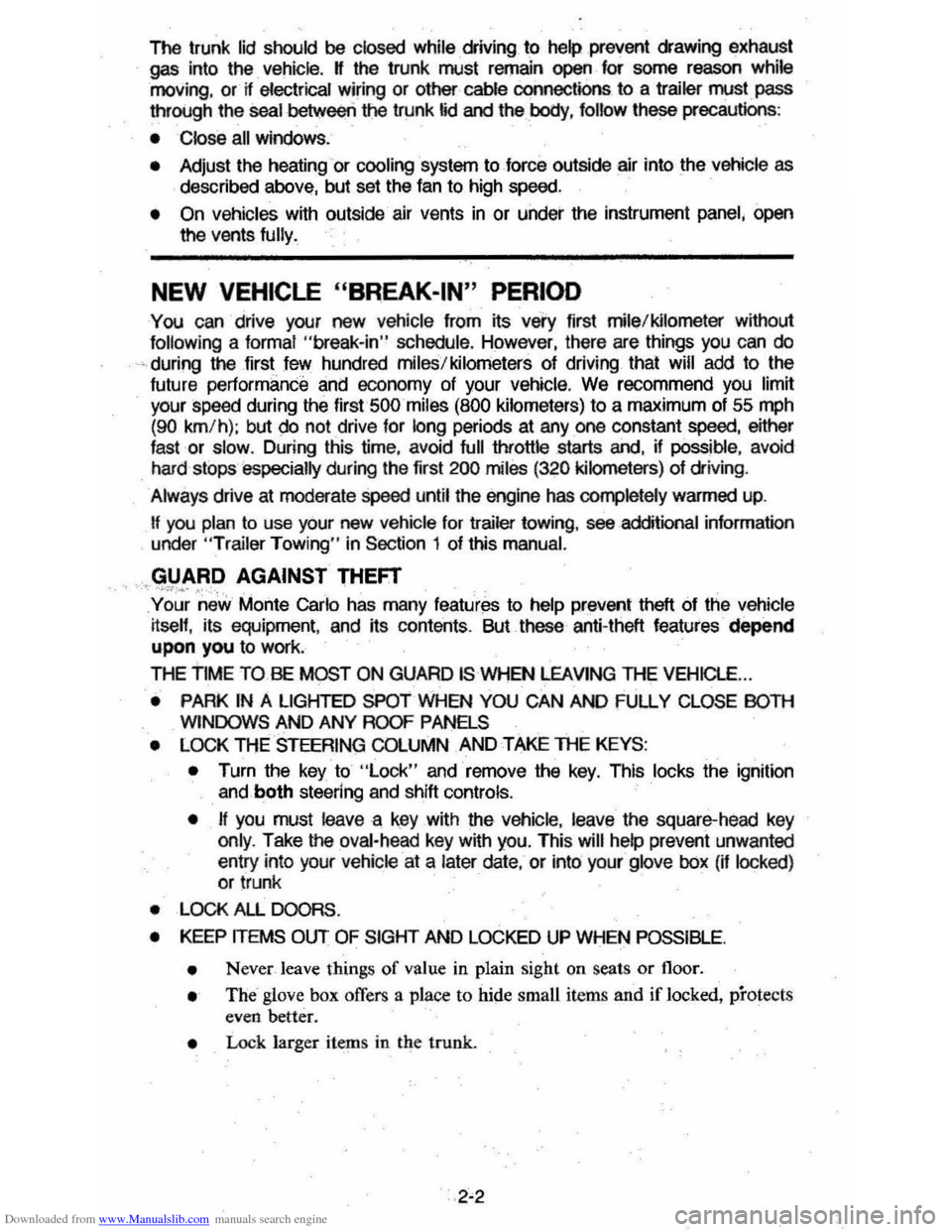
Downloaded from www.Manualslib.com manuals search engine The trunk lid should be closed while driving to help prevent drawing exhaust gas into the vehicle. If the trunk must remain open for some reason while
moving . or ff electricai wiring or other cable conneclionS to a trailer must pass through the sealbelweeri the trunk lid and the body, follow these precautionS :
• Close all windows.
• Adjust the heating or cooling system to force outside air into the vehicle as
described above. but set the fan to high speed .
• On vehicles with outside ' air vents in or under the instrument panel ; open
the vents
fully.
NEW VEHICLE "BREAK-IN" PERIOD
You can drive your new vehicle from its very first mile/kilometer without
following a formal "break-in" schedule. However. there are things you can do during the first few hundred miles/kilometers of driving . that will add to the
future performance and economy of your
vehicle. We recommend you limit
your speed during the first 500 miles (800 kilometers) to a maximum of 55 mph (90 km /h) ; but do not drive for long periods at anyone constant speed. either
fast or
slow. During this time. avoid full throttle starts and. if possible. avoid
hard stops especially during the first 200 miles (320 kilometers) of driving .
Always drive at moderate speed until the engine has COfl'4lletely warmed up.
If you plan to use your new vehicle for trailer towing . see additional information
under " Trailer Towing" in Section 1 of this manual.
GUARD AGAINST THEFT
y~~; '~ew Monte carlo has many features to help prevent theft of the vehicle
itself.
its equipment. and its contents. But these anti-theft features depend
upon you to work.
THE
TIME TO BE MOST ON GUARD ISWHEN LEAVING THE VEHICLE ...
• PARK IN A LIGHTED SPOT WHEN YOU CAN AND FULLY ClOSE BOTH WINDOWS AND ANY ROOF PANaS
• LOCK THE STEERING COLUMN AND TAKE THE KEYS:
•
Turn the key to "Lock " and remove the key. This locks the ignition
and both steering and shift controls.
• If you must leave a kilY with the vehicle . leave the square-head key only. Take the oval· head key with you. This will help prevent unwanted
entry into your
vehicle at a later date . or into your glove box (if locked) or trun k
• LOCK ALL DOORS .
•
KEEP ITEMS OUT OF SIGHT AND LOCKED UP WHEN POSSIBLE.
• Never leave things of va lue in plain sight on seats or floor.
• The glove box otTers a place to hide small item s and if locked, protects even better.
• Lock larger item s in the trunk.
Page 22 of 104
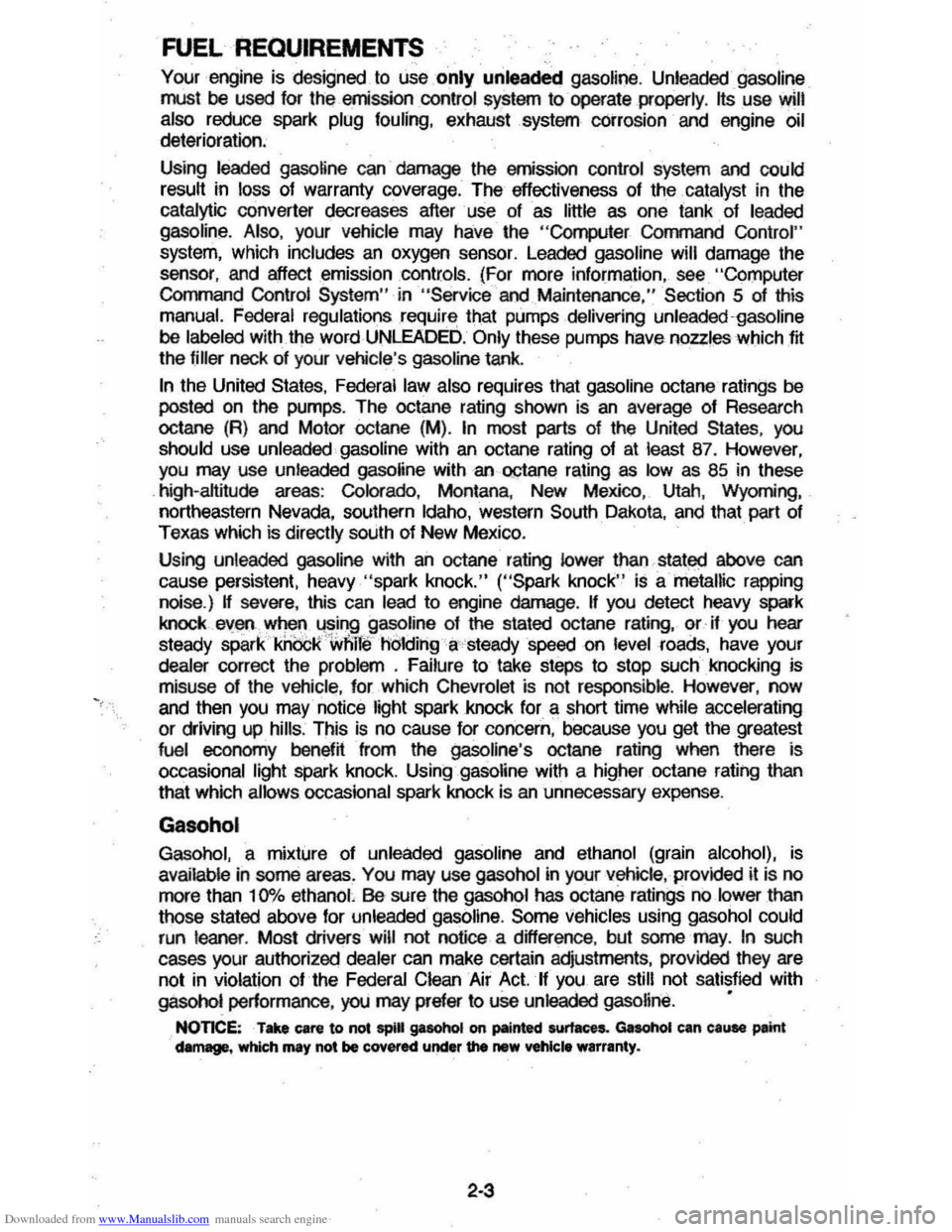
Downloaded from www.Manualslib.com manuals search engine FUEL REQUIREMENTS
Your engine is designed to use only unleaded gasoline . Unleaded gasoline must be uSed for the emission control system to operate properly . Its use will
also reduce spark
plug fouling, exhaust .system corrosion and engine oil deterioration.
Using
leaded gaso~ne can damage the emission control system and could
result
in loss of warranty coverage. The effectiveness of the catalyst in the
catalytic converter decreases after use of as little as one tank of leaded
gasoline.
Also, your vehicle may have the "Computer Command Control" system, which includes an oxygen sensor. Leaded gasoline will damage the
sensor,
and attect emissioncont(ols. (For more information, see "Computer
Command Control
System" in "Service and Maintenance,"Section 5 of this manual. Federal regulations require that pumps delivering unleaded-gasoline
be labeled with the word UNLEADED. Only these pumps have nozzles whichftl the filler neck of your vehicle's gasoline tank.
In the United States, Federal law also requires that gasoline octane ratings be
posted on the pumps. The octane rating shown is an average of Research
octane (R) and Moto< octane (M). In most parts of the United States , you
should use unleaded gasoline with an octane rating of at least 87. However,
you may use unleaded gasoline with an Q!;tane rating as low as 85 in these
. high -altitude areas: Coloraclo , Montana, New Mexico , Utah , Wyoming,
northeastern Nevada, southern Idaho, western South Dakota, and that part of
Texas which is directly south of New Mexico .
Using unleaded gasoline with
an octane rating lower than stated above can
cause persistent, heavy
"spark knock." (" Spark knock" is a metallic rapping
noise.) " severe, this can
lead to engine darnage. " you detect heavy spark knock even ",hery using gasoline of the stated octane rating, 0<. if you hear steady spark knoo~ 'wfiil.)' Holding a' steady speed on level roads, have your
dealer correct the
problem . Failure to take steps to stop such knocking is
misuse
of the vehicle, for which Chevrolet is not responsible . However, now and then you may notice light spark knock for a short time while accelerating
or driving
up hills : This is no cause fo< concern, because you get the greatest
fuel economy
benem from the gasoline's octane rating when there is
occasional light spark knock. Using .gasoline with a higher .octane rating than
that which
allows occasional spark knock is an unnecessary expense.
Gasohol
Gasohol, a mixture of unleaded gasoline and ethanol (grain alcohol), is
available in some areas , You may use gasohol in yourvehicle ,provided it is no
more than 10% ethanoL Be sure the gasohol has octane ratings no lower than
those stated above for unleaded
gasoline . Some vehicles using gasohol could run leaner . Most drivers will not notice a difference, but some may. In such
cases your authorized dealer can make c.ertain adjustments, provided they are
not in violation of the Federal
Clean Air Act. " you. are still not satisfied with gaSOhol performance , you may prefer to uSe unleaded gasoline. •
NOTICE: ,Take care to not spiH gasohol on painted surfaces. Gasohol can cause paint damage, which may not be covered und~r the new vehicle warranty.
2·3
Page 23 of 104
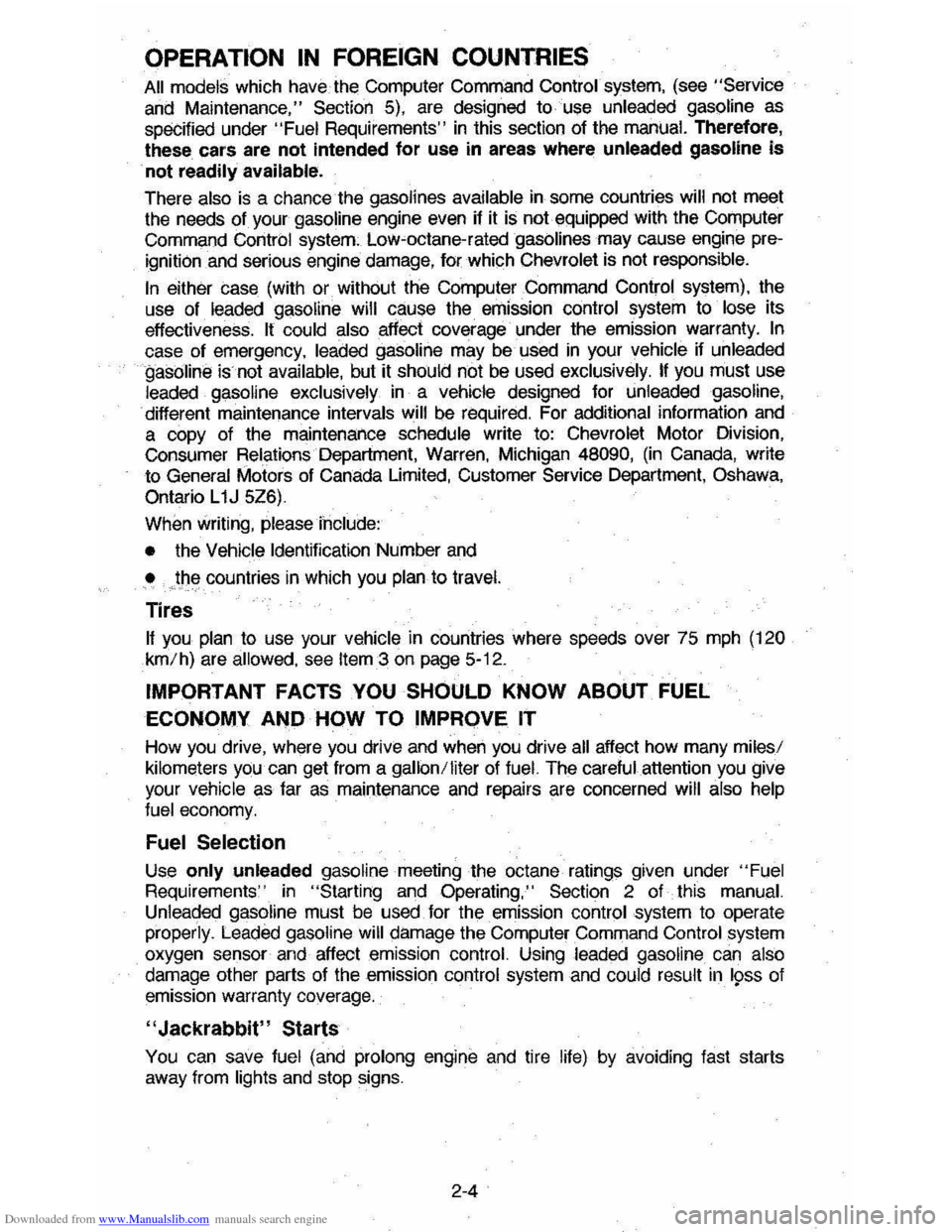
Downloaded from www.Manualslib.com manuals search engine OPERATION IN FOREIGN COUNTRIES
All models which have the Computer Command Control system, (see "Service
and Maintenance," Section 5), are designed
to use unleaded gasoline as
specified under
"Fuel Requirements" in this section of the manual. Therefore,
these cars are not intended for use in areas where unleaded gasoline is
not readily available,
There also is a chance the gasolines available in some countries will not meet the needs of your gasoline engine even if it is not equipped with the Computer
Command Control system; Low~octane-ratedgasolines may cause engine pre
ignition and serious engine damage, for which Chevrolet is not responsible.
In either case (with or without the Computer Command Control system), the
use of leaded gasoline will cause the emission control system to lose its
effectiveness.
It could also affect coverage· under the emission warranty. In
case of emergency, leaded gasoline may be used in your vehicle if unleaded gasoline is not available, but it should not be used exclusively. If you must use
leaded gasoline exclusively
in a vehicle designed for unleaded gasoline,
different maintenance intervals will be required. For additional information and
a copy of the maintenance schedule write to: Chevrolet Motor Division, Consumer Relations Department, Warren, Michigan 48090, (in Canada, write
to General Motors of Canada Limited, Customer Service Department, Oshawa,
Ontario
L 1J 5Z6).
When writing, please
include:
•
the Vehicle Identification Number and
• the countries in which you plan to travel.
Tires
If you plan to use your vehicle in countries where speeds over 75 mph (120
km/h) are allowed, see lIem3 on page 5-12.
IMPORTANT FACTS YOU SHOULD KNOW ABOUT FUEL
ECONOMY AND HOW
TO IMPROVE IT
How you drive, where you drive and when you drive all affect how many miles/
kilometers you can get from a galion/liter of fuel. The careful attention you give
your vehicle as far as maintenance and repairs are concerned
will also help
fuel economy.
Fuel Selection
Use only unleaded gasoline meeting the octane ratings given under "Fuel Requirements" in "Starting and Operating," Section 2 of this manual.
Unleaded gasoline must be used. for the. emission control ,system to operate
properly. Leaded gasoline will damage the Computer Command Control system
oxygen sensor and affect emission control. Using leaded gasoline can also
damage other parts of the emission control system and
CQuld result in 19s8 of
emission warranty coverage.
"Jackrabbit" Starts
You can save fuel (and prolong engine and tire life) by avoiding fast starts
away from lights and stop signs.
2-4
Page 24 of 104
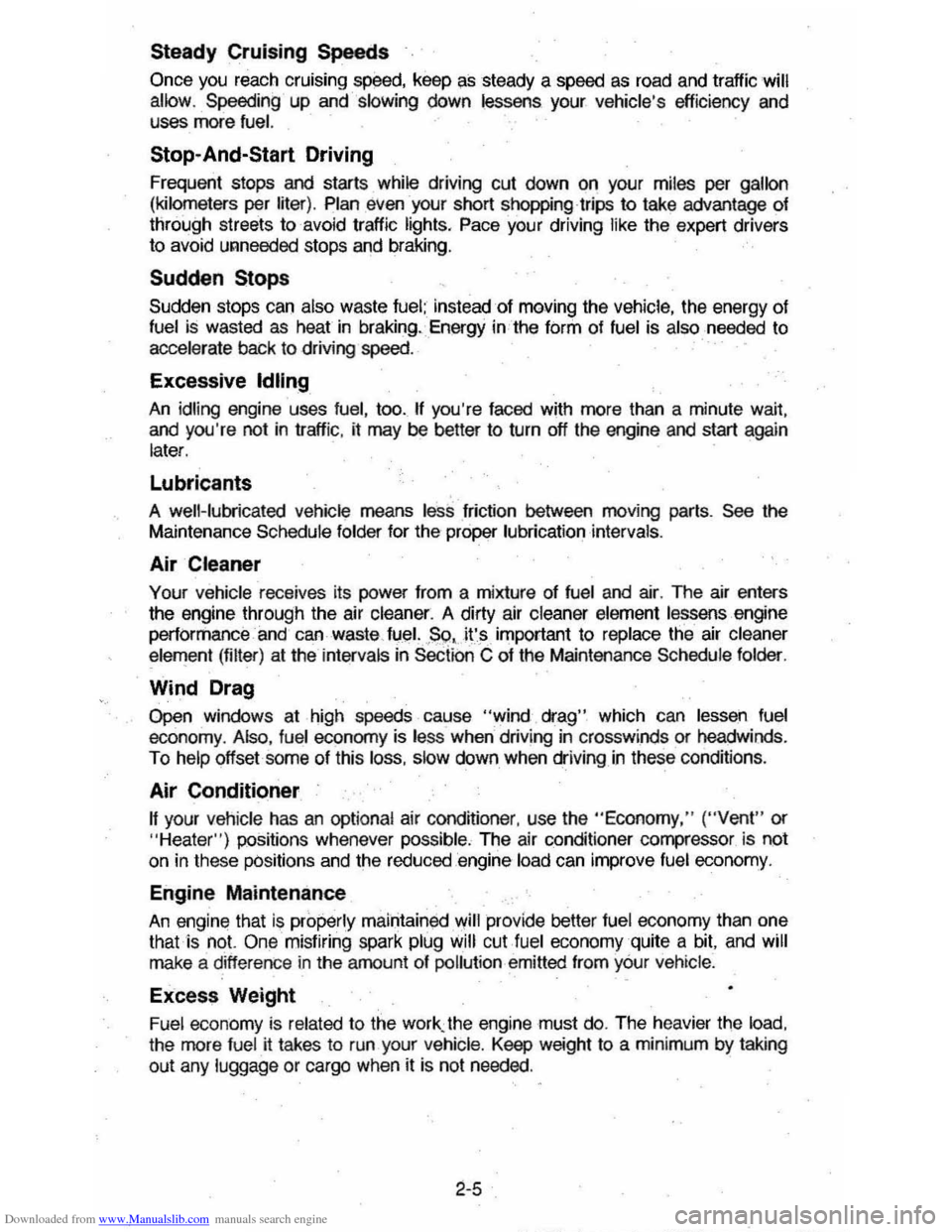
Downloaded from www.Manualslib.com manuals search engine Steady Cruising Speeds
Once you reach cruising sPeed, keep as steady a speed as road and traffic will allow . Speeding up and slowing down lessens your vehicle's efficiency and uses more fuel.
Stop-And-Start Driving
Frequent stops and starts while driving cut down on your miles per gallon
(kilometers per liter) . Plan even your short shopping trips to take advantage of
through streets to avoid traffic lights. Pace your driving
like the expert drivers
to avoid unneeded stops and braking .
Sudden Stops
Sudden stops can also waste fuel; instead of moving the vehicle, the energy of fuel is wasted as heat in braking. Energy in the fOrm of fuel is also needed to
accelerate
baCk to driving speed.
Excessive Idling
An idling engine uses fuel, too .. If you're faced with more than a minute wait,
and you're not in traffic , it may be better to turn off the engine and start again
later.
Lubricants
A well-lubricated vehicle means less friction between moving parts. See the Maintenance Schedule folder for the proper lubrication intervals.
Air Cleaner
Your vehicle receives its power from a mixture of fuel and air. The air enters
the engine through the air cleaner. A dirty air cleaner element lessens engine
perfOrrnance and can waste/Uel. ,So, it's important to replace the air cleaner
element (filter) at the intervals in Section C of the Maintenance Schedule folder .
Wind Drag
Open windows at high speeds cause "wind drag" which can lessen fuel
economy. Also, fuel economy is less when driving in crosswinds or headwinds .
To
help offset some of this loss, slow down when driving in these conditions.
Air Conditioner
" your vehicle has an optional air conditioner , use the "Economy, " ("Vent" or
"Heater") positions whenever possible. The air conditioner compressor, is not on in these positions and the reduced ,'engine-load can improve fuel economy.
Engine Maintenance
An engine that i. properly maintained ."iill provide better fuel economy than one
that is no\.
One misfiring spark plug will cut .fuel economy quite a bit, and will make a difference in the amount of pollution emitted from yOur vehicle.
Exces~ Weight
Fuel economy is related to the work. the engine must do. The heavier the load,
the more fuel it takes to run your vehicle. Keep weight to a minimum by taking
out any luggage or cargo when it is not needed.
2-5
._ - ---_._---'----
Page 25 of 104
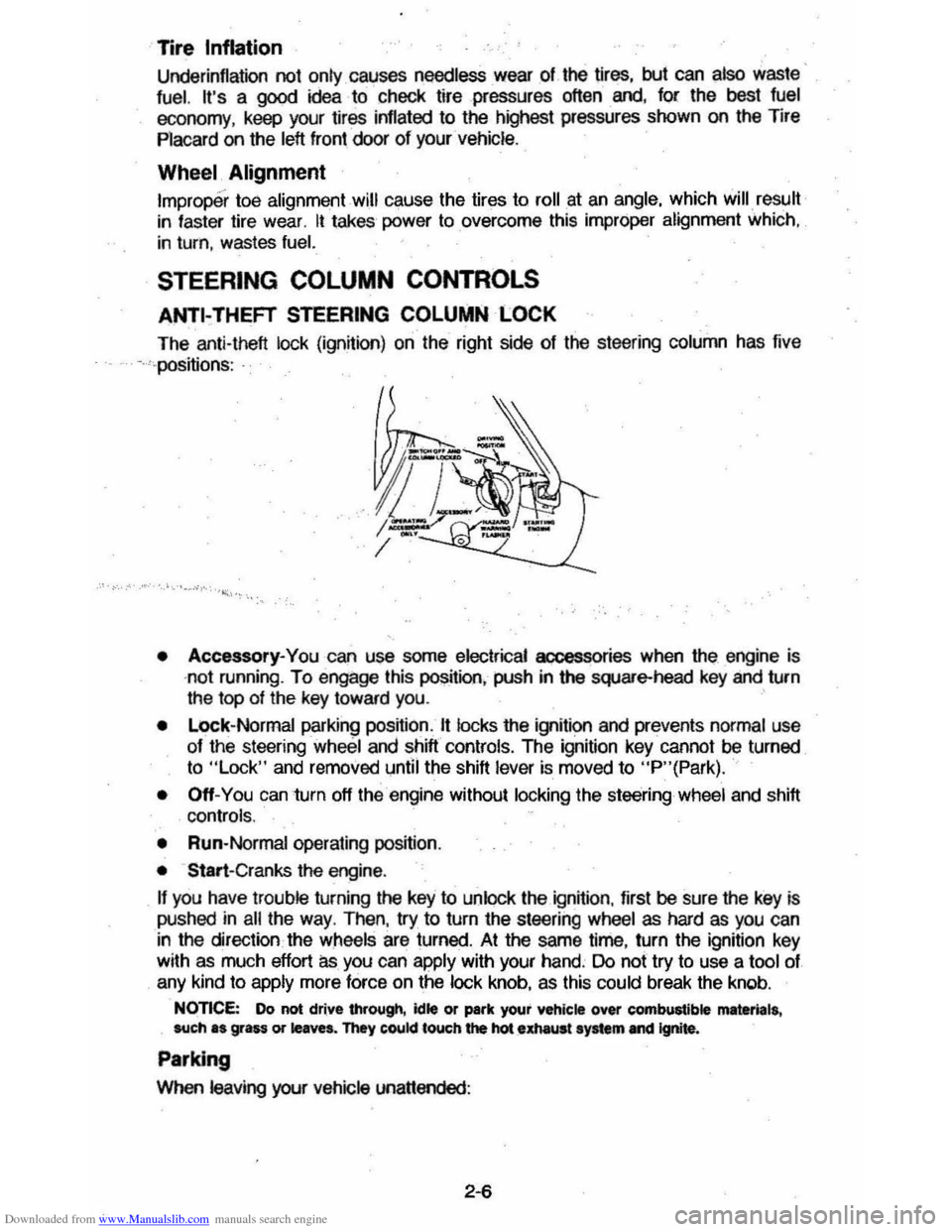
Downloaded from www.Manualslib.com manuals search engine Tire Inflation
Underinflation not only causes needless wear 01 the tires, but can also waste ' fuel. It's a good idea to check tire pressures often and, fO( the best fuel
eccnomy, keep your tires inflated to the highest pressures shown on the Tire
Placard on the left front door of your vehicle .
Wheel Alignment
Improper toe alignment will cause the tires to roll at an angle, which will result in faster tire wear. It takes' power to overcome this improper alignment which.
in turn, wastes fuel.
STEERING COLUMN CONTROLS
ANTI-THEFT STEERING COLUMN LOCK
The anti-theft lock (ignition) on the right side of the steering column has five
-""'positions: .
• Accessory-You can use SO
• Lock -Normal parking position. It locks the ignition and prevents normal use
of the steering
wheel and shift controls. The ignition key cannot be turned
to "Lock" and removed until the shift lever is moved to "P"(Park).
• Off-You
can turn off the engine without locking the steering wheel and shift controls.
• Run-Normal operating position.
• Start-Cranks the engine.
If you have trouble turning the key to uniock the ignition, first be sure the key is
pushed in
all the way . Then , try to turn the steering wheel as hard as you can
in the direction the
wheels are turned. At the same time, turn the ignition key
with as much effort as you can apply with your hand; Do not try to use a tool of
any kind to
apply more force on the lock knob, as this could break the knob .
NOncE: Do not drive through, idle or park your vehicle over combustible marla Is, .uch •• grass or leaves. They could touch the hot eJlhauat .ystem .-.cIlgnite.
Parking
When leaving your vehicle unattended :
2-6
Page 26 of 104
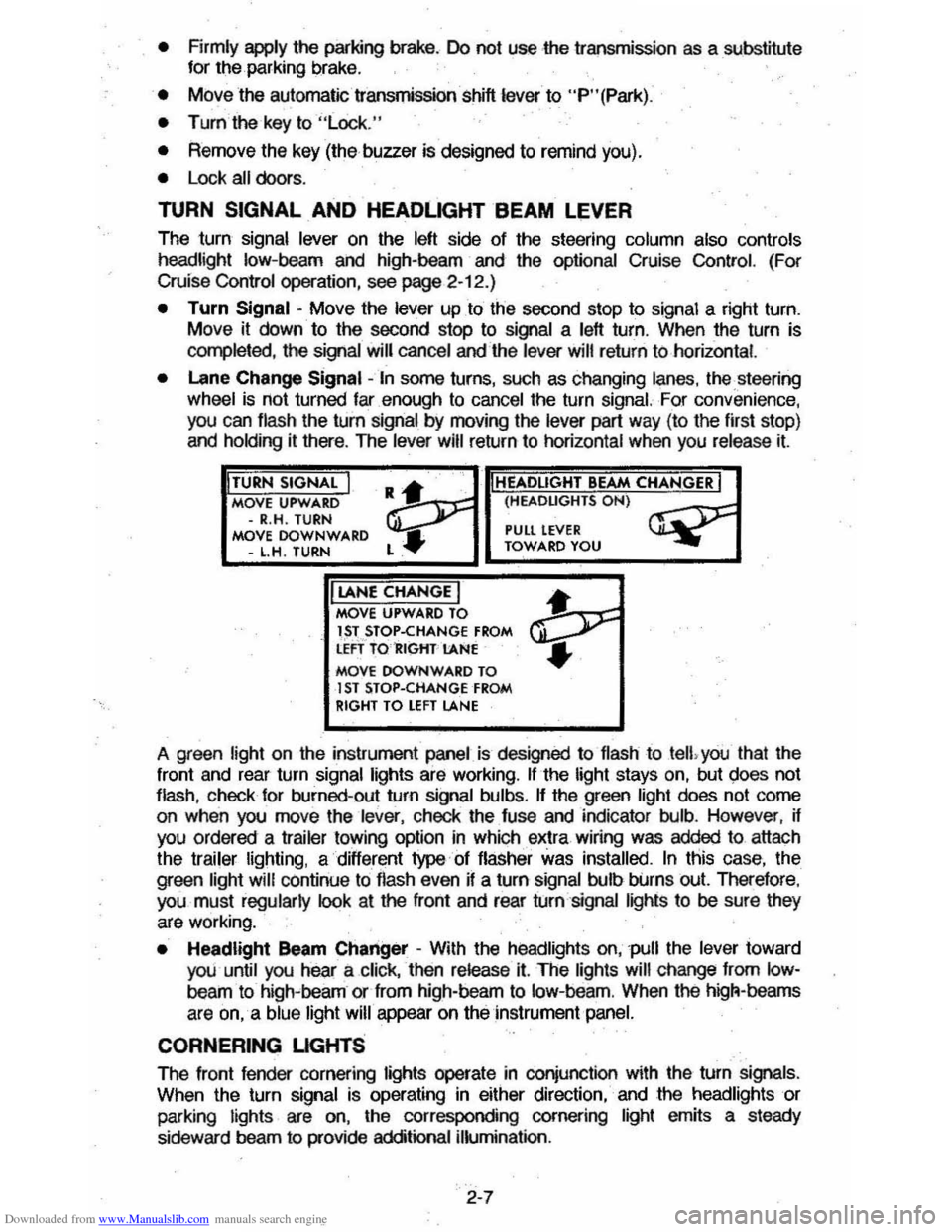
Downloaded from www.Manualslib.com manuals search engine • Firmly apply the parking brake. Do not use ·the transmission as asubsmute for the parking I)rake.
•
Move the automatic transmission shift lever to "P"(Park).
•
Turn the key to "Lock ."
•
Remove the key (the · buzzer is designed to remind you).
• Lock all doors .
TURN SIGNAL AND HEADLIGHT BEAM LEVER
The turn signal lever on the left side of the steering column also controls
headlight low-beam and high-beam and the optional Cruise Control. (For Cruise Control operation, see page 2-12.)
• Turn Signal -Move the lever up to the second stop to signal a right turn.
Move it down to the second stop to signal a left turn. When the turn is
completed, the signal will cancel and the lever will return to horizontal.
• Lane Change Signal -In some turns, such as changing lanes, the steering wheel is not turned far enough to cancel the turn signal . ·For convenience,
you can flash the turn signal by moving the lever part way (to the first stop)
and holding it there. The lever will return to horizontal when you release it.
TURN SIGNAL MOVE UPWARD -R.H. TURN MOVE DOWNWARD -l.H. TURN
I LANE CHANGE I MOVE UPWARD TO
HEADLIGHT BEAM CHANGER (HEADUGHTS ON)
PUtl LEVER TQWARDYOU
l$T STOP-CHANGE FROM LEFT TO 'RIGHT lANE
MOVE DOWNWARD TO 1ST STOP-CHANGE FROM RIGHT TO LEFT LANE
A green light on the instrument panel is designed to flash to tell, you that the
lront and rear turn signal lights are working . If the light stays on, but does not
flash, check for burned-out turn signal bulbs.
If the green light does not come on when you move the lever, check the fuse and indicator bulb. However, if
you ordered a traiter towing option in which extra wiring was added to attach
the
trailer lighting, a different type'of flasher was installed. In tliis case, the
green light will continue to flash even if a turn signal bulb bUrns out. Therefore ,
you must
regularly look at the front and rear turn signal lights to be sure they
are working.
• Headlight Beam Changer -With the headlights on, pull the lever toward
you until you hear a click, then release it. The lights will change from Iow
beamto high-beam or from high-beam to low-beam . When the hig~-beams
are on, a blue light will appear on the instrument panel.
CORNERING UGHTS
The front fender cornering lights operate in conjunction with the turn signals.
When the turn signal is operating in either direction, and the headlights or
parking
lights are on, the corresponding cornering light emits a steady
sideward beam to provide additional illumination .
2-7
Page 27 of 104

Downloaded from www.Manualslib.com manuals search engine STARTING THE ENGINE
For vehicles sold in Canada which do NOT. have the. Computer Command
Control system, pleru;e refer to the Owner's Manual Supplement supplied with
your
vehicle for engine starting procedures . (If a "Check Engine" light comes
on during engine starting, your
vehicle does have the Computer Command
Control system.)
1. Apply the parking brake.
2 . Move
the transmission shill lever to "P"(Park) or "N"(Neutral) ("P"
preferred). A starter . safety device is designed to keep the starter from
operating if the shift
lever is in .any drive position . (If you need to re-start
the engine while the vehicle is moving, move the shift lever to "N ." )
3 . Start the engine .as outlined below for different conditions . Be sure to
follow the instructions which apply to your engine . (The Engine Code is the
8th digit on the
VIN plate at the lower left side of your windshield . See
. "SpeCifications" .Section 7 oUhis manual for more details.) "~" ...
NOTICE: Do not crank the engine 'or more than about 15 seconcls at a time. Wait 10 to 15 seconds before trying again. Thla will hetp prevent damage to the starter.
• COLD ENGINE
•
All Engines -Press the accelerator pedal to the floor and slowly
release it. With your foot 011 the pedat, crank the engine by turning
the ignition key to "Start." Release the key when the engine starts.
If the engine does not start or starts, but fails to run, repeat this
procedure
.
• .• • .
,., .•..• ·Whe!\. '.he engine is running smoothly (about 30 seconds), you can reduce
the engine
idle speed by pressing clown onthe.accelerator · pedal. then slowly releasing ~. .
NOTICE : If the engine runS a long time (S minutes or more) without pressing down the accelerator pedal, overheating OOl,lkf'C;.auM : damage -to 'the engine and exhaust system. ' I, .
Do not Ie.Y~ yoot vehicle ,unattended with the engine . running. H the engine should overllut, you would not be there to I'NCt to the temperatwe wwnlng light Of gaga. This
could reaun if! costly damage to your vehicle and Ita contents.
• Warm Engine
• All -Do not press clown the accelerator pedal. With your foot off
the
pedal , crank the engine by turning the ignition key to "Start." II the
engine
does not start after 3 seconds of cranking, press clown the
accelerator pedal to 1 /3 of its. travel while cranking. Release the key
(and accelerator pedal) when the enginjl starts.
• Very Cold We'lther (Below -1S"C Or O"F Or After Vehicle Has Been Standing Idle Several Days) • Before cranking the engine, fully depress
and release the accelerator
pedal one or . two times more than stated for
your engine under
"Cold Engine" .starting. Then, with your foot-oil the
accelerator pedal, crank the engine by turning the ignition key to "Start." Release the key when the engine starts.
4 .
Apply the regular brakes and shift into. the proper gear. Release the
parking brake and
drive off.
2-8
Page 28 of 104

Downloaded from www.Manualslib.com manuals search engine H Engine Fails To Start After Normal Starting Pr.ocedure:
1 . If you tried the cold ef1gine starting procedure and the engine did not start,
then
fully depress and release the acceleraior pedal several times. Take
your foot off the
pedal and crank the engine by turning the key to "Start."
2. If you tried the warm engine starting procedure (or the eold engine
procedure
and Step 1 above) , and the ef1gine still does not start, press the
accelerator pedal to the floor and hold it there while cranking the engine.
This should clear the engine if it is flooded. .
3. If the engine has been flooded with too much fuel, It may start to run but not have enough power to keep running, In that case, continue
cranking
with 11M! accelerator pedal aU the way to the 1100< until the
engine clears
~self of excess gascHne and runs smoothly. (But, do not
crank more than 15 seconds atatime Or you could damage the starter.)
TRANSMISSION
DESCENDING A GRADE
CAUTION : Before ,:,9C)i1l9,d ,01!Wn a steep or long grade, reduce speed and shift the transmission Into low or second gear '9 ~1p
Whether your vehiCle has an optional limited-slip rear axle or a standard axle ,
usecare,,¥t\1
Sudden acceleration or engine braking action (due to
shilling to a lower ge,n)
could cause one or both drive wheels to spin or skid and the rear of the vehicle
to slide sideways on the crowned · surface.of a road or in a turn, Normal skid
correction is
called for at these times.
AUTOMATIC TRANSMISSIONS
Automatic transmissions replace the standard cMch and transmission. After
starting
the engine with the selector lever in"P" (Park) or "N" (Neutral)
position, select the range desired
(see table) and depress . the accelerator. A
gradual start
with a steady increase in accelerator pressure will result in best
possible fuel economy . Rapid acceleration for fast startS will result in greater
fuel consumption. ..
AutomatiC transmission shift quadrants of all GM vehicles continue the uniform
sequence of
selector positions. Shift indiCators are arranged with "P"(Park)
position atone end, followed in sequElf)ce by "R"(Reverse). "N"(Neutral) and
the forward
driving , ranges .. All .automatic transmiSsions are equipped with a
starter safety switch'
design'ld to permit starting the ef1gine only when the transmission selector is in the "P"(Park) or"N"(Neutral) position. For
additional engine braking
eflact, as SOmetimes needed in mountainous driving,
place thetransmi$Sion in an intermediate or low range.
2'9
::"
Page 29 of 104
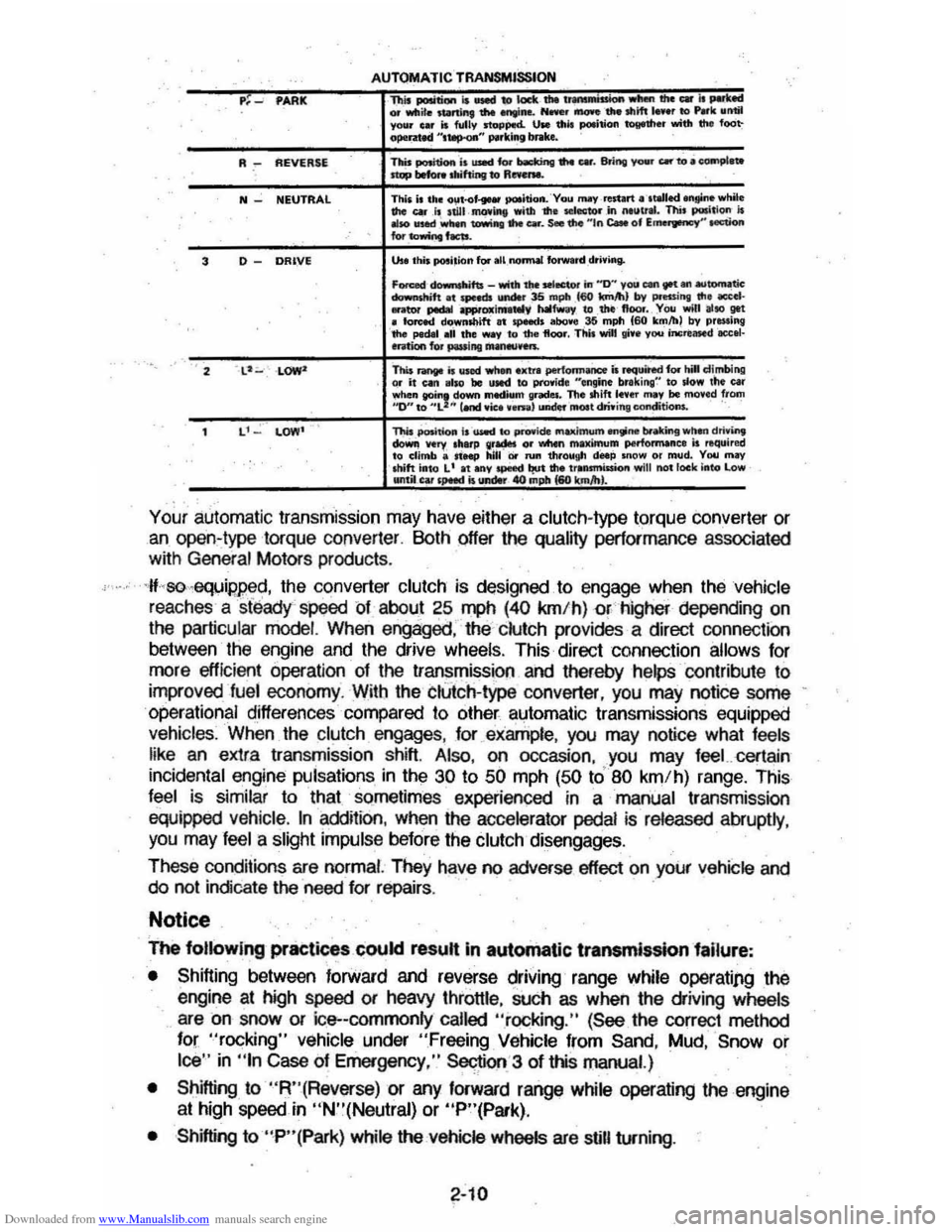
Downloaded from www.Manualslib.com manuals search engine P~ _ PARK
R ~ REVERSE
N _ NEUTRAL
.. '
3 D -DRIVE
L''': LOW' '
AUTOMATIC'TRANSMISSION This position is __ to lock .. u~ ...... the _ islNdted or white JUftInt 1M engIH ......... __ -the Ihift .... r to .... 11. .. Mil YOlir elr is fully stoPped. Use thif; pcIIition 1Otf1h.r with the foot'opel'ded "I~" .,.rlr.lnl b .. ke.
TIllis ,.,.otioR i, UIMI for Ndcing .... Uf. Bti,. yoM _ to.-..I_ nop before doiking to R-. -
This il the ollt-of-9Hf pc)Iltion. YOII may resUr! "ltalled Inginl while the Q)r it uill--II1CWiIIt with the selector ,in 0.1111". Thi. poIitlon is "so !ned wIMfI tawi"" ...
Forced dotonsIoita _ with t~ selector in "0.' you ean fM. an .utotnatic *'-shift It speeds unct.r 15 I'IIptI 100 Ir.mJhl by precsi"l ttle accel· _ator pedIII app,OIIim''' ,Y ..... fw.,. tClthe noar. , You wttJ '''10 get , forced downsnift at 5P"d$ IlboW$ ,35 mph 160 km/h) by prelling 'the pedlll ,II the way to the floor. This will gin you irw.: .. 1INd ace.J· ention for puling 1NnMIftn.
"This Pootnoct i. wed to pcoooide ..,Mimum""'ne brioking wlm! dmint doWiI .... 'Y, .h.rp II'~ or whtn m.ximum perlormanc. is required to climb a It..., hili or run throllgh deep ""OW or mild. You miIY lhift into L' It any tPMd but the trlllrmiS$ion will not loek into Low until_UI' spaid is ~ 40 ,"ph 160 k"""). --c-
Your automatic transmission may have either a clutch-type torque converter or an open,type torque COnverter . Both offer the quality performance associated
with General Motors products.
·~-so·_equipped, the converter clutch is designed to engage when the vehicle reaches a st)lady speed of about 25 mph (40 km/h) or, higher depending on
the particular model. When engagEid, the' clutch providE.s a direct connection
between the engine and the drive
wheels. This direct connection allows for
more efficient operation of the transmission and thereby helps contribute to
improved
fuel economy. With the ClUtch-type converter, you may notice some
operational d,ifferences · compared to other. automatic transmissions equipped vehicles. When the clutch engages , for example, you may notice what feels
like
an extra transmission shift. Also, on occasion, you may feeLcertain
incidental engine pulsations in the 30 to 50 mph (50 to' 80 km/h) range. This feel is similar to that so.rnetimes experienced in a manual transmisSK>n
equipped vehicle. In addrtion, when the accelerator pedal is released abruptly,
you may feel a slight impulse before the clutch disengages.
These conditions are normal. They have no adverse effect on your vehicle and do not indicate the need for repairs . .
Notice
The following practices could result in autoinatic transmission failure:
• Shifting between forWard and reverse driving' range while operati/lg the
engine at high speed or heavy throttle, such as when the driving wheels
are on snow Of ice--commonly called "rocking." (See the corre<:t method
for
"rocking" vehiCle under "Freeing Vehicle from Sand, Mud, Snow or Ice" in "In Case of Emergency," Sectiorl.'3 of this manual.)
•
Shifting to "R"(Reverse) or any forward range while operating the engine
at high speed in "N"(Neutral} or "P"(Park).
• ·Shifting to "P"(Park) while the vehicle wheels are still turning.
2-10
Page 30 of 104
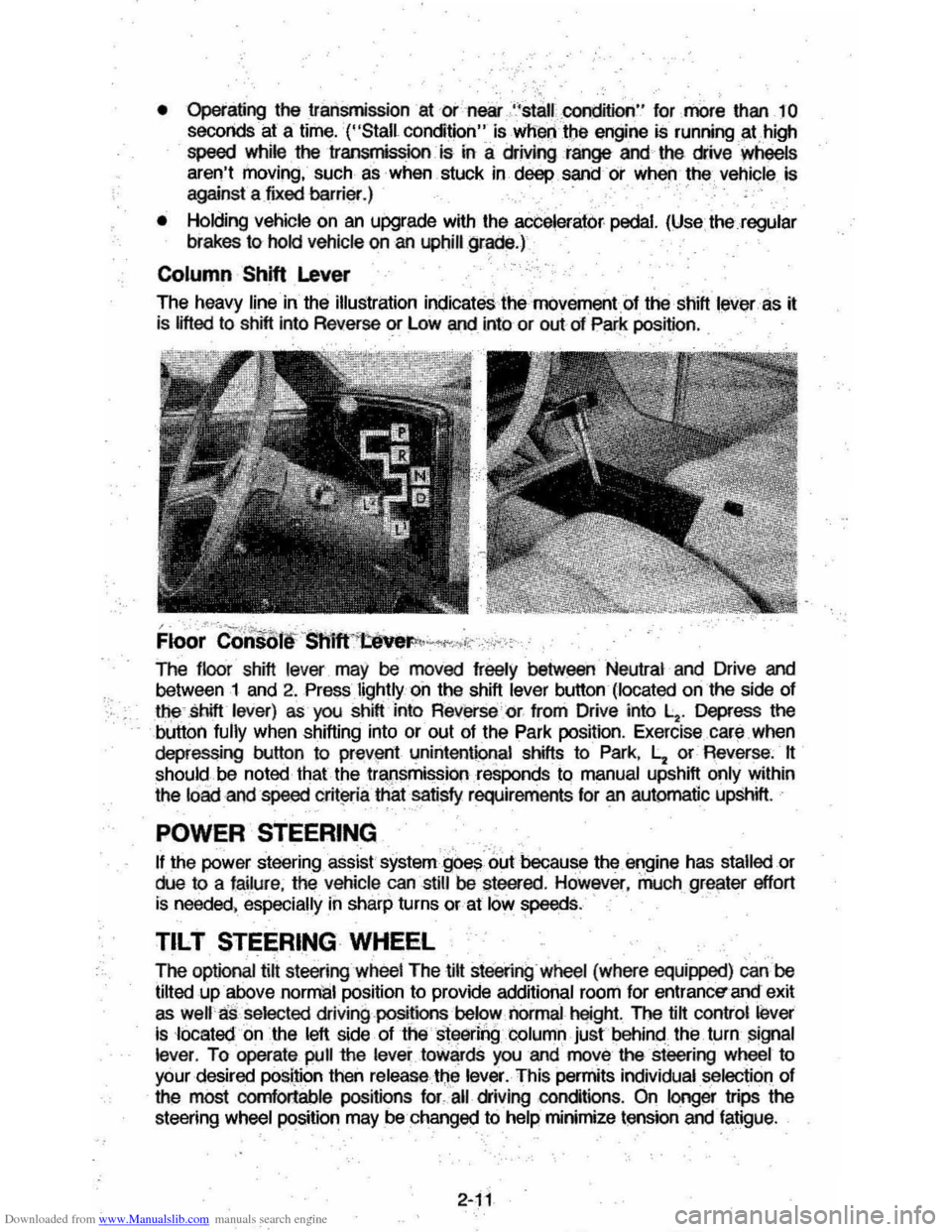
Downloaded from www.Manualslib.com manuals search engine • Opet'ating the transmission at 'Of 'near,"st8Jlcondition" lor more than 1 0
secorlds at a time, ("Stall condition" is wfj~~ t~e engine is running at ,high
speed while the transmission is in a driving range arid the drive wtieels
aren't moving, such as when stuck in deep sand or whe(l the vehicle is
against a fixed barrier.) ,
•
Holding vehicle on an upgrede with the acCelerator pedal. (\Jse the regular
brakes to hold vehicle on an uphill grade.)
Column Shift Lever
The heavy line in the illustration indicatesihe movementol the shift lever as it
is lifted to shift into Reverse Of Low arid into or out 01 Park position . ,
~ ---. .,.-'.' . ...,..~;~.. .. .. -- -' -, .-,--. Floor ConsOliFSI\1ff~"~,,(C'·,':"
The floor shift lever may be moved freely between Neutral and Drive arid between 1 and 2. Press lightly oil the shift lever button (located on the side 01
'. ttie-shift lever) as you shift into ReviJ(se ' or from Drive into ~, Depress the
button fully when shifting into or out 01 the Park position . ExerCise ,care when
depressing button to
prev,!"'t unintenti
the
load ,arid speed criteria that satisfy requirements lor an autDmatic upshift, ~ -. - -.
POWER STEERING
II the power steering assist' system goes'''' ut beeaus .e the engine has stalled or due to a lailure , the vehicle can ,still be steered . However , much greater eitort
is needed , especially in sharp turns or at
low speeds . '
TILT STEERING WHEEL
The optional tilt steering wheel The tilt steering wheel (where equipped) can be
tilted up above
normal position to provide edditional room lor entrance' and exit
as
well'ss . selected driving ,positions bei<>w ilormalheight. The ti~ control lever is located on the left side 01 the steering.'column just behind . the turn signal
lever . To operate pull
the lever tow'¥ds you and move the steering wheel to
your desired
pos!~on then releaSe!?e lever. This permits individual seleclion 01 the most comfortable positionS lor. all driving conditions , On longer trips the
steering wheel position may be changed to help minimize tension
and latigue.
2-11
. ------ ,------